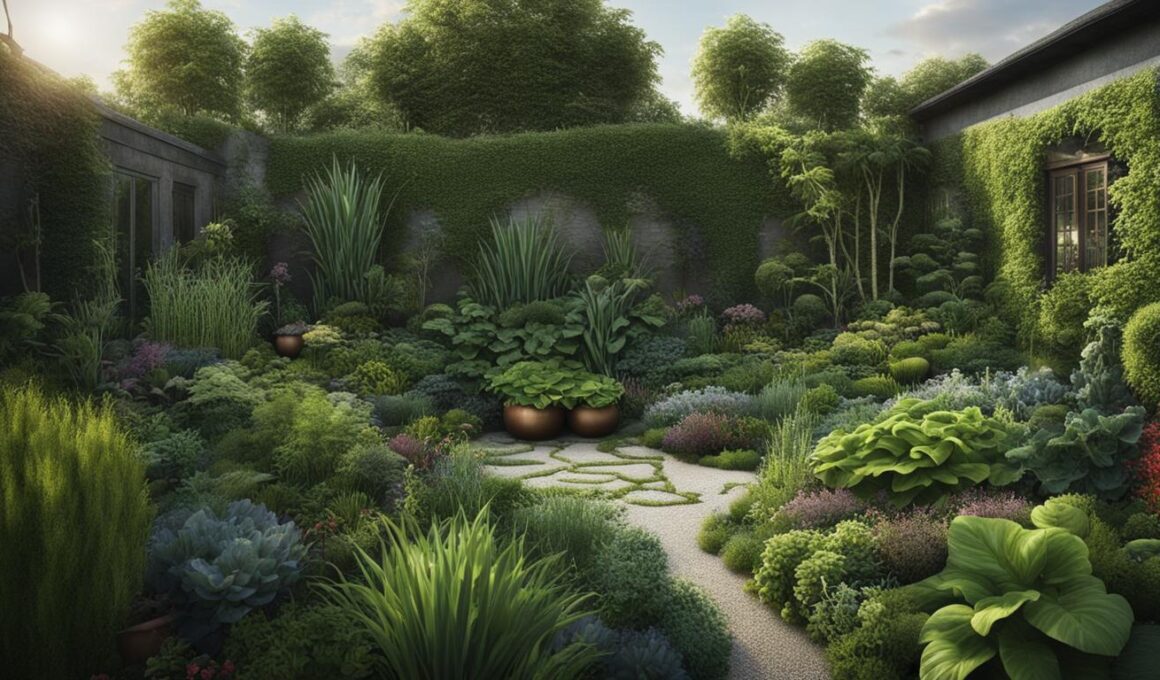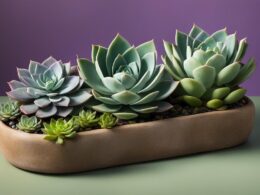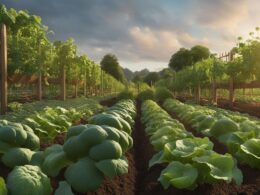Plant spacing is a crucial consideration for gardeners. The distance between plants can have a significant impact on their health, growth, and overall productivity. It’s important to understand the proper plant spacing to ensure your garden thrives. In this article, we will explore the dangers of planting too close together and provide guidelines for spacing flowers and perennials.
Post Summary:
- Proper plant spacing is essential for healthy plants and optimal growth.
- Spacing plants too closely can lead to diseases, root rot, and pest infestations.
- Adequate spacing promotes better air circulation and prevents overcrowding.
- Consider the mature size of plants and leave enough room for growth.
- Annual flowers can be used to fill gaps and add color within the garden bed.
Factors to Consider for Proper Plant Spacing
Proper plant spacing offers numerous benefits that contribute to the overall health and aesthetics of your garden. One of the key advantages of spacing your plants correctly is maintaining their long-term health. Adequate spacing allows plants to grow into their maturity without becoming overcrowded or misshapen. This not only ensures optimal growth but also promotes better air circulation around the plants, reducing the risk of fungal diseases. When plants have enough space to breathe, moisture can evaporate from their leaf surfaces more easily, preventing the development of harmful diseases.
Additionally, proper plant spacing improves the visual appeal of your garden. By giving each plant enough room to grow and spread, you can prevent a tangled mess of branches and create a harmonious landscape. Overcrowded plants tend to bloom poorly and have a higher likelihood of developing pest and disease problems. On the other hand, well-spaced plants have access to ample sunlight, water, and nutrients, which contribute to healthier and more vibrant blooms.
Considering the benefits of plant spacing, it is crucial to take into account the mature size of your plants when determining the appropriate spacing. Measuring plant spacing from the center of one plant to the center of the next ensures consistency and accuracy. You can use a circle-based method, matching the circle’s diameter to the mature size of each plant. Planting different-sized plants together may require using an average of their mature sizes to determine the spacing. To fill gaps in your garden, consider planting small annual flowers in groupings, creating colorful borders or adding pops of color within the flower bed. Don’t forget to mulch the bed to retain moisture and provide a finished look.
In summary, proper plant spacing is vital for the long-term health and visual appeal of your garden. It ensures optimal growth, improves air circulation, and reduces the risk of diseases. By considering the mature size of your plants and providing enough room for growth, you can create a beautiful and thriving landscape that will bring you joy for years to come.
Guidelines for Plant Spacing in the Garden
When it comes to planting in your garden, proper spacing is key to ensuring the health and growth of your plants. Understanding the mature size of plants and following guidelines for spacing can help create a beautiful and thriving landscape. Here are some important guidelines to consider:
Measuring Plant Spacing
The first step in determining plant spacing is to know the mature size of the plants you want to plant. This information can usually be found on plant tags or in catalogs. When measuring plant spacing, it is important to measure from the center of one plant to the center of the next. This ensures that plants have enough room to grow without overcrowding.
Circle-Based Method
One effective method for determining plant spacing is the circle-based method. This involves creating a circle around each plant with a diameter that matches its mature size. For example, if a plant is expected to grow to a diameter of 3 feet, the circle around it should also have a 3-foot diameter. This method ensures that plants have enough space to grow without interfering with each other.
Spacing Different-Sized Plants
When planting different-sized plants together, it is important to consider the average of their mature sizes to determine the spacing. This ensures that all plants have adequate room to grow and thrive. By spacing plants according to their average mature size, you can create a visually appealing garden that allows each plant to reach its full potential.
Filling Gaps with Annual Flowers
In some cases, there may be gaps between plants in your garden. These gaps can be filled with small annual flowers, which can add pops of color and create a more visually engaging landscape. Planting annual flowers in groupings can help fill in these gaps and create borders or focal points within the garden.
Remember, proper plant spacing is essential for the health and aesthetics of your garden. By following these guidelines and allowing enough room for plants to grow, you can create a beautiful and thriving landscape that will bring you joy for years to come.
The Consequences of Poor Plant Spacing
Planting plants too close together can have detrimental effects on their health and overall visual appeal. Overcrowding plants can lead to a variety of issues, including competition for resources, the need for excessive pruning, and stunted plant growth. Let’s explore the consequences of poor plant spacing in more detail:
1. Overcrowding:
When plants are planted too closely together, they end up competing for essential resources such as water, nutrients, and sunlight. This competition can result in stunted growth and poor development. Plants may struggle to access enough resources to thrive, leading to weakened immune systems and increased susceptibility to diseases and pests.
2. Excessive Pruning:
In an attempt to control the growth of overcrowded plants, gardeners often resort to regular pruning. While pruning can help maintain the plants’ appearance, it can be time-consuming and may alter the natural form of the plant. Additionally, frequent pruning can be stressful for the plants and may disrupt their natural growth patterns, impacting their overall health and vigor.
3. Visual Appeal:
Poor plant spacing can negatively impact the visual appeal of a garden. When plants are planted too close together, they can become tangled and misshapen as they compete for space to grow. Overcrowding can also lead to an unorganized and cluttered appearance, diminishing the overall aesthetic of the garden.
4. Competition for Resources:
Plants that are planted too closely together must compete for essential resources, including water, nutrients, and sunlight. This competition can result in uneven distribution and limited availability of these resources, leading to imbalances in plant growth and reduced overall health. Adequate spacing allows each plant to access the resources it needs to thrive and reach its full potential.
Ensuring proper plant spacing is crucial for the long-term health and vitality of your garden. By providing sufficient room for each plant to grow and thrive, you can prevent overcrowding, minimize the need for excessive pruning, and create a visually appealing and harmonious landscape.
| Consequences | Effects |
|---|---|
| Overcrowding | Stunted growth, increased susceptibility to diseases and pests |
| Excessive Pruning | Altered natural form, increased plant stress |
| Visual Appeal | Tangled and misshapen plants, cluttered appearance |
| Competition for Resources | Uneven distribution of water, nutrients, and sunlight |
Conclusion
In conclusion, plant spacing is of utmost importance for the overall health and aesthetics of your garden. By adhering to proper plant spacing guidelines, you can ensure that your plants thrive and flourish. Adequate spacing allows plants to access essential resources such as sunlight, water, and nutrients, leading to healthier and more productive growth.
Moreover, proper plant spacing plays a critical role in disease prevention. Improved air circulation between plants reduces the risk of fungal diseases and pest infestations. This can save you from the hassle of dealing with plant health issues and the need for extensive treatments.
Optimal plant spacing also contributes to the visual appeal of your garden. When plants are allowed enough room to grow and develop, they maintain their natural form and shape, creating a harmonious and beautiful landscape. Avoiding overcrowding and giving each plant sufficient space is key to achieving a visually pleasing garden.
By recognizing the importance of plant spacing and implementing the recommended guidelines, you can create a garden that thrives with healthy plants, provides a visually stunning environment, and ensures optimal growth and productivity for years to come.
FAQ
Can plants be too close together?
Yes, planting plants too close together can have negative consequences. Overcrowding can result in plants competing for water, nutrients, and sunlight, leading to poor growth and reduced blooming. It can also make pruning and maintenance more difficult.
What are the benefits of proper plant spacing?
Proper plant spacing ensures curb appeal, promotes long-term plant health, reduces competition for resources, and improves air circulation around plants, helping prevent fungal diseases. It also allows plants to grow into their maturity without becoming overcrowded or misshapen.
How do I determine the proper spacing for plants?
Before planting, consider the mature size of the plants. Measure plant spacing from the center of one plant to the center of the next using a circle-based method, where the circle’s diameter matches the mature size of the plant. For different-sized plants, use the average of their mature sizes to determine spacing.
What are the consequences of poor plant spacing?
Poor plant spacing can result in overcrowding, competition for resources, misshapen plants, increased risk of diseases and pests, and decreased visual appeal. It may also require frequent pruning to maintain appearance and affect the natural form of the plant.
Why is plant spacing important?
Proper plant spacing is important for the health and aesthetics of a garden. It ensures plants have access to sunlight, water, and nutrients, resulting in healthier and more productive plants. It also reduces the risk of diseases and pest infestations, improves air circulation, and allows each plant to develop a healthy root system.










